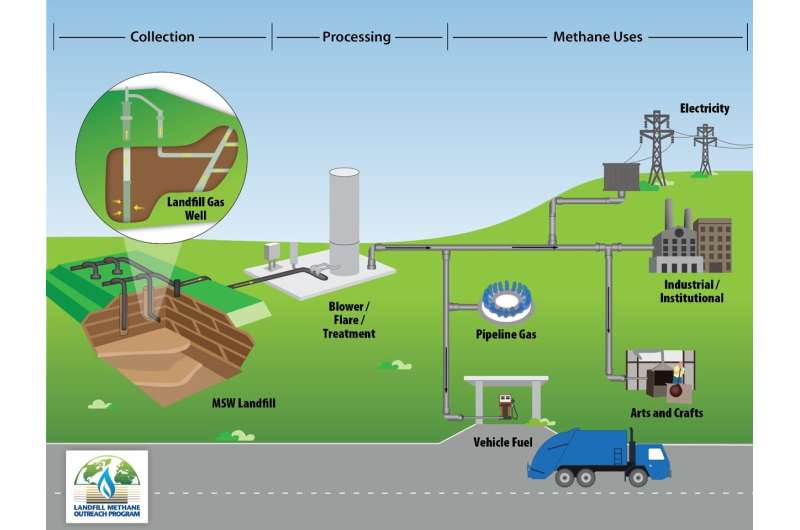Methane from waste should not be wasted: Exploring landfill ecosystems

Each year, humans across the globe produce billions of tons of solid waste. Roughly 70% of this refuse ends up deposited in landfills, where it slowly decays. Yet, what may seem an inert accumulation of useless debris, is in reality, a complex ecosystem, teeming with microbial activity. Vast communities of microorganisms feed on the waste, converting it into byproducts—primarily carbon dioxide (CO2) and methane.
While most landfill methane is captured and flared away, researchers hope instead to make use of this resource, which can be converted into fuels, electricity or used for heating homes (see below).
In a new study published in the journal Applied and Environmental Microbiology, lead author Mark Reynolds, along with his Arizona State University and Industrial colleagues, explore these microbial communities flourishing in leachate, a liquid percolating through solid waste in a landfill. They find that the composition and behavior of specific microbes found in arid landfills, like those in Arizona, are distinct from similar communities in more subtropical or temperate climates. Microbial composition also differs depending on the age of the landfill deposits.
The project was carried out at the Salt River Landfill located in Scottsdale, near ASU's Tempe campus. The facility receives about 1,600 tons of municipal solid waste daily.
Solid waste: A breakdown
The study explores ecosystem-level microbial composition in leachate. Diverse environmental conditions seemingly affect the microbial niches that are compartmentalized across the landfill's 143 acres.
"I think of a landfill as like a big carbon buffet to these microorganisms," says Reynolds, a researcher in the Biodesign Swette Center for Environmental Biotechnology. "Our trash is mostly paper-heavy and it's really rich in cellulose and hemicellulose. These are readily degradable under anaerobic (oxygen-free) conditions."
The capture and use of gases produced in landfills can help reduce hazards associated with landfill emissions, and prevent methane from escaping into the atmosphere. Further, energy projects associated with the capture and processing of landfill gas can generate revenue and create jobs in the community.
By better understanding the behavior of these methane-producing microorganisms, researchers hope to improve the capture of this vital resource and possibly limit the escape of methane and CO2—two potent greenhouse gases and leading contributors to climate change—into the atmosphere.
"We're diving into ecological theory to try to get to the source of what might be driving the organizational patterns of the methane-producing organisms," Reynolds says. The study's multifaceted analysis indicates that temperature and dissolved solids are the two key parameters governing their abundance and diversification. This is good news, because this data is routinely captured at landfill sites commonly on a monthly basis and can provide accurate diagnostics—telltale indicators of broad trends in overall methane production.
From garbage to fuel
Municipal solid waste landfills accounted for over 15% of methane emissions in 2019, representing the third largest source of global methane emissions. As the study notes, emissions of methane from landfills amount to the equivalent of a billion tons of CO2, or roughly the greenhouse emissions produced by nearly 22 million cars driven for a year.
Typically, most of the methane released by microorganisms in a landfill is captured as biogas and subsequently flared off, converting it to CO2. Although this method limits the climate-damaging effects of the methane itself, it is a short-term and inadequate solution to the problem of greenhouse gas emission from landfills.
In addition to its adverse effect on the climate, the lost methane represents a missed opportunity to capture this valuable resource. The study estimates that approximately one-fifth of the nation's landfills would be suitable for such capture and processing, if economic and other hurdles can be overcome.
Currently, microorganisms degrading municipal solid waste generate landfill gas consisting of roughly 50% methane and 50% CO2. By understanding the subtle workings of these microorganisms—particularly, methanogenic Archaea, which are the real workhorses in the methane production cycle—researchers hope to boost methane output.
The increased methane can be harvested and used to create electricity, carbon neutral fuels or to heat homes. The latter option is particularly attractive as no further processing of the methane would be required. Alternately, modifying microbial communities could potentially be used to limit methane output, where mitigation is desired.
On the hunt for Archaea
Landfills provide an ideal setting for the detailed study of Archaea, which are notoriously challenging to culture in the laboratory. Roughly 80% of archaea diversity remains largely unexplored. "Our labs are really interested in the methanogens because the same metabolism they enact in the wetlands, which make them the highest source of methane, or instead the human gastrointestinal tract, they enact in the landfills," Reynolds says.
Because the methanogens are primitive, single-celled organisms, they can equally make use of plant, or food matter, or paper products. While the study found similar methane concentrations at their arid landfill site compared to other landfills, different communities of methanogens are doing the heavy lifting. The study demonstrates that microbial behavior is also dependent on the age of the solid waste deposited. Younger waste is higher in temperature compared with older waste and degrades according to different regimes. The aridity has also been shown to greatly affect solid waste breakdown over time.
"There's a restructuring or reorganization of these arid climate microbes in landfills," Reynolds says. Future investigations will be aimed at clarifying the distinctions in these communities relative to their temperate and humid counterparts.
Further research will explore landfill microbial communities in greater detail as well as the use of biostimulants or other techniques that could be used to modify methane production.
More information: Mark C. Reynolds et al, Delineating the Drivers and Functionality of Methanogenic Niches within an Arid Landfill, Applied and Environmental Microbiology (2022). DOI: 10.1128/aem.02438-21
Journal information: Applied and Environmental Microbiology
Provided by Arizona State University





















